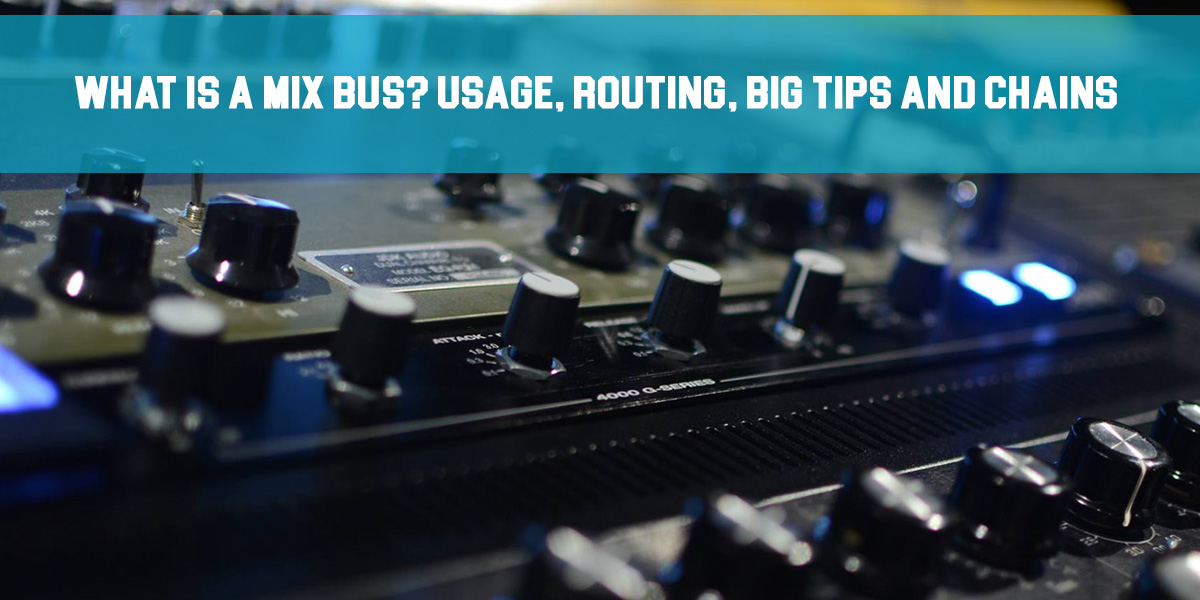Flanger vs Phaser vs Chorus
Introduction
The time we live in right now is fantastic for guitar players. Not too long ago, most guitarists only had a few overdrive pedals, maybe a distortion or two, and a reverb. Today, things are very different.
While there are many unique-sounding audio effects for sound design, there are a few you’re likely to come across time and time again: chorus, flangers, and phasers. These effects are all related and are often confused with one another, but they have important differences that are worth pointing out.
It’s possible to use these effects without knowing exactly how they work, but understanding what’s really happening will let you use them more deliberately and effectively.
One of the most interesting types of guitar effects pedals are modulation effects. When we talk about modulation effects, we’re mainly referring to flangers, phasers, and chorus pedals.
These three are similar in some ways, which has led many people to mix them up. The three effects we’re looking at here—chorus, flange, and phase—are all part of the modulation family of effects. So before we go any further, let’s define what “modulation” means.
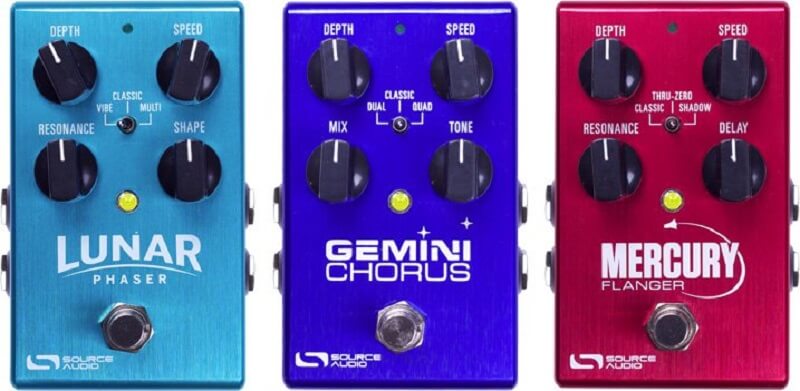
What Is Modulation?
When it comes to modulating sound, the definition can get pretty complicated. In technical, scientific, or electronic terms, modulation means “the process of varying one or more properties of a periodic waveform, called the ‘carrier signal,’ with a modulating signal.”
Let’s break that down into something simpler. Basically: “a modulation effect is one that changes your signal in a repeating and interesting way. This not only adds movement to your sound, but it also gives it more width and depth.”
As you might know, when used tastefully, effects like chorus, flanger, and phaser can add extra life and a bright sparkle to your sound. Even less subtle uses can be musically pleasing. So, how do these effects work? Simply put, modulation pedals change the frequency (pitch), amplitude (volume), or phase of your guitar’s signal in clever and musical ways.
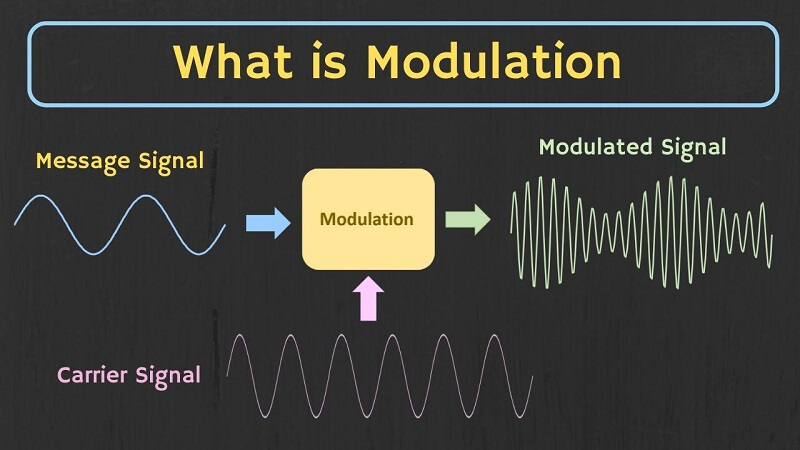
Why Everybody Needs To Know The Distinction Between These Effects
Besides the obvious fact that modulation plays a huge role in shaping modern guitar tone, understanding the differences between these three effects can really benefit you as a guitar player and music producer.
Guitar effects are, at their core, tools. They’re meant to add flavor to your music and help you express yourself with more nuance. You can use all three of these effects in the same song, and each one can bring something unique to the table.
For example, a chorus pedal is perfect for highlighting certain parts of a solo, while flangers work great on rhythm guitar. Knowing how to get the most out of each of these effects can really help you in your musical journey. But, being able to truly tell flangers, phasers, and chorus pedals apart will completely change how you use them.
Flangers are known for being wild and addictive. For many players new to this effect, trying out a flanger can feel like falling down a rabbit hole with no end in sight.
If you go overboard with the amount of flange on a track, the effect can shift from adding a bit of flavor to completely taking over the song. No one wants that, no matter how cool it sounds. Chorus and phaser effects are generally more forgiving, even when used more heavily.
Let’s take a closer look at what these three effects actually are:
What is Flanger?
Flangers are one of the weirdest, yet ultimately addictive effects out there. A flanger takes the source signal, duplicates it, and then adds a small amount of delay to one copy, all while changing the delay time as you play. The result is a sound that’s a lot like a jet engine flying overhead.
A flanger isn’t too different from a phaser, but it can sound much wetter. The effect happens when the signal is split in two—one part is delayed and then layered back on top of the other. The most pleasing flangers usually run at delay times below 15ms, though the rate control can change that. The famous “swoosh” of a flanger comes from the delayed signal’s time being varied up and down in a constant cycle.
As for the name: legend has it that a producer was running two identical audio tracks and pressed against the flange of the tape reel to slow one down just a bit, making it run slightly out of sync. Hence, “flanger.”
This story is hotly debated, though. George Martin once said the term came from John Lennon while recording the Revolver album. Lennon was asking about “artificial double tracking,” and Martin jokingly replied, “Now pay attention, it’s quite simple. We take the original image and split it through a double vibrated sploshing flange with double-negative feedback.”
Lennon took the joke further, and Martin said, “Well, let’s flange it again and see.” Lennon went on to call it “Ken’s Flanger,” after Abbey Road engineer Ken Townsend performed the trick of copying the vocal line and delaying it slightly. The technique was later developed into stereo and was first credited to Eddie Kramer during the recording of Hendrix’s Axis: Bold as Love in 1967.
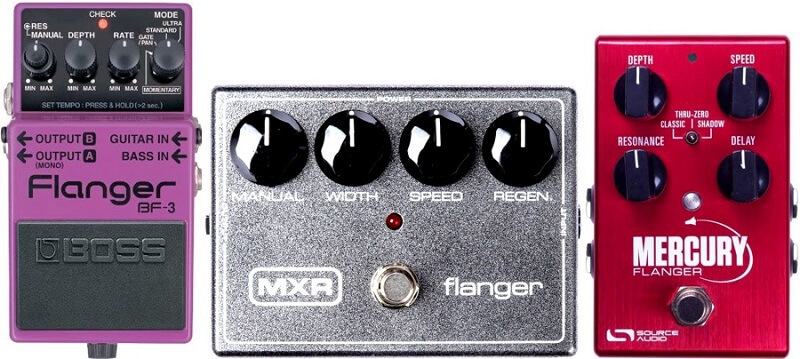
What is Chorus?
‘Chorusing’ is the sound that happens when several voices or instruments play the same note, but each one is slightly different in pitch and timing. Just think about how a real choir or string section works.
This effect creates a rich, shimmering quality that sounds much bigger than a single voice or instrument could. Chorus is usually described as lush and clear, but it can be pushed to extremes for more “alien” or unusual sounds.
Chorus pedals are designed to mimic the wavering, spacious sound of a choir. They work especially well in a stereo setup, where the effect comes from two widely spaced amplifiers. If you stand between the amps in a large room, it creates a surreal 3D effect for your ears.
A well-set chorus pedal can really thicken and color your sound, adding depth, dimension, and richness—making it seem like there are multiple guitars playing together with you!
Chorus pedals remain very popular—not quite as trendy as they were in the ’80s, but still strong sellers today. There are many classic examples of chorus on guitar, including “Come As You Are” by Nirvana, “Walking on the Moon” by The Police, the clean parts of “Welcome Home (Sanitarium)” by Metallica, “Pretty Woman” by Van Halen, “I Will Follow” by U2, and of course, “More Than a Feeling” or just about anything by Boston.
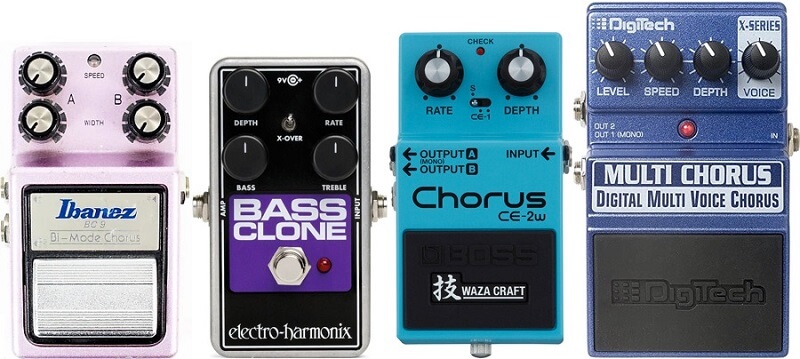
What is Phaser?
It shouldn’t be a surprise that phase shifters (also called phasers) work on a similar principle to chorus and flanger effects, with one key difference.
Like those other effects, phasers create a copy of the original signal. But instead of delaying the signal, the copy is sent through a special circuit called an “all-pass filter.” This type of filter doesn’t change the level of any frequency in the signal, but it does shift the phase of certain frequencies.
If you connect another all-pass filter after the first, you end up creating a single notch (one dip in a comb filter effect). Phasers string several of these all-pass filters together in a row, which creates a series of non-harmonically related notch filters.
An LFO (low-frequency oscillator) is then used to move these notch filters up and down, similar to how a flanger works. Because the phaser’s notch filters aren’t harmonically related, the resulting sound is smoother and more subtle—falling somewhere between a chorus and a flanger.
The main difference is that phasers create a Doppler-like effect, and that’s essentially what they do. Many people confuse phasers with flangers because they both have a sweeping character at their core.
However, the way they sweep is not the same. Flangers create their sweeping sound by changing the timing of a delay, while phasers use filters to block certain parts of the frequency range. Put simply, phasers are more orderly and predictable, while flangers tend to sound less controlled.

Conclusion
These processors are often confused because they share similarities, but each uses phase shifting in its own way. Chorus combines phase shifting with pitch modulation, flangers use it to create harmonic-based comb filtering, and phasers rely on all-pass filters to shift phase without using delays.
Although chorus, flangers, and phasers may seem only slightly different in their features and uses, all three can be powerful tools for crafting interesting timbres in sound design.
Their ability to add atmosphere, a sense of space, and evolving timbres—in ways that standard processors can’t—makes them essential for any producer or sound designer’s toolkit.

